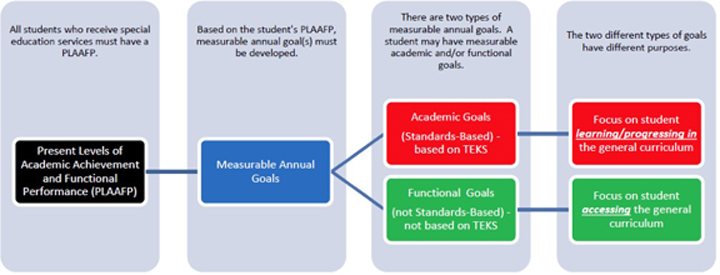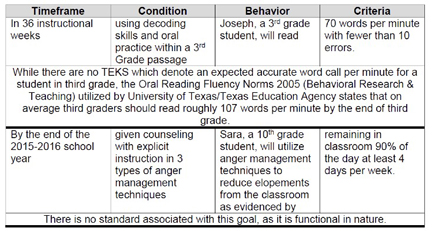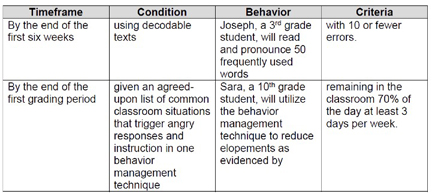Once you and the ARD committee have reviewed your child’s PLAAFP, the team should be clear about what your child can do and where your child needs help. Based on this information, you and the ARD committee will write a new set of goals for your child for the next school year. Simply put, an IEP goal is a target for what your child will learn in a school year. Annual goals identify the areas in which a student with a disability needs special education services or specially designed instruction.
The purpose of IEP goals (and all special education services) is to assist the student in accessing and progressing in the general education curriculum. Your child’s IEP may include two different types of goals:
- Academic (standards-based) goals, which are directly linked to progressing toward enrolled grade-level content standards, and/or
- Functional (non-standards-based) goals, which assist the student in accessing the enrolled grade-level content standards.

While not a requirement, objectives may be written into the IEP along with the goals. Objectives are short-term “benchmarks” or “milestones” that can be used to measure a child’s progress toward the bigger target – the goal. The parent may request that short-term objectives be included to help track how their child is progressing toward his/her annual goals.
NOTE: If your child will take an alternate statewide assessment based on alternate achievement standards (STAAR Alternate 2), all of your child’s annual goals must include short-term objectives.
You don’t have to be a certified special educator to help write good IEP goals. As you work with the ARD committee to develop goals, remember this:
Annual goals should be based on the PLAAPF. As you work with the other members of the ARD committee to develop goals, refer to the PLAAPF statements to identify the skills you believe should be a priority for the upcoming school year.
Academic goals should be standards based. This means that each academic goal should be tied to the curriculum (TEKS) for your child’s grade level. You can find the TEKS on the TEA website here or in the Curriculum Framework. The curriculum tells you what your child is supposed to know or be able to do within each academic year along with pre-requisite skills. You can use the TEKS standards as a starting place for writing goals and objectives.
All all goals should be measurable. Measurable goals are defined as statements that include:
- Timeframe – How much time will it take for the student to achieve the goal (such as number of weeks or a certain completion date)?
- Conditions – What specific resources are needed for a student to reach the goal (such as an accommodation or use of an assistive technology device)?
- Behavior – What is the performance or action being monitored?
- Criterion – How much, how often, or to what standard must the behavior occur in order to demonstrate that the goal has been achieved?
Based on what you know your child can do right now (PLAAPF) and what he/she should be learning (TEKS), you are ready to participate in writing your child’s IEP goals and objectives. Look at these 2 charts to see examples of written measurable goals (chart 1), followed by written measurable short-term objectives (chart 2).
Chart 1: Measurable Goals

(With thanks to ESC 20’s Progress in the General Curriculum – IEP Annual Goal Development Q&A) Examples:
Chart 2: Measurable short-term objectives that lead to the goals in Chart 1

(With thanks to ESC 20’s Progress in the General Curriculum – IEP Annual Goal Development Q&A)
Avoid Common Pitfalls – Some Key Pointers
- IEP goals should be written as a team – and you are a part of that team. If your ARD committee presents IEP goals that were developed without your input, ask for time to review those and compare those to your own ideas. Consider requesting an ARD Planning Conference or Pre-ARD meeting to participate in the development of goals.
- The “I” in IEP stands for “Individualized”. Make sure your child’s is just that. IEP goals should not be automatically produced for an entire group of students. It shouldn’t be a computer generated piece of paper that doesn’t properly take your child’s individuality into account. Many schools use computer programs as a time-saving convenience, and there’s nothing wrong with that, as long as it can be tailored to the needs of your individual child. Your participation in IEP development can help ensure that it is.
- The school and IEP goals are not a substitute for good parenting. The things you would teach your child at home – if there were no disability – are the same things you should teach your child – at home – in spite of the disability. When you handle the functional skills you can at home, you free the school up to address those critically important academic skills.
- The IEP drives the student’s placement. IEPs that include age appropriate academic goals are more likely to lead to placements in the regular education classroom. Goals that are strictly functional in nature, may lead to a more separate, segregated kind of educational placement. To many parents, that might seem like a good thing, but we encourage you to consider the long-range impact of specialized and segregated settings. Read more about placement and check out this easy planning matrix.
- The IEP is not a laundry list of wants and needs. It’s easy to fall into the trap of writing goals for everything you want to see happen for your child. However, there is only so much time in a day. Don’t dilute the teacher’s efforts by writing too many goals than cannot be effectively met in a school day and year. Prioritize your child’s needs and focus on the big things that will make a difference in your child’s life.
The Litmus Test for IEP Goals & Objectives:
Ask yourself these questions about each goal or objective. If you can answer “yes”, then write it in the IEP. If no, strike it or rewrite it!
1. Does it make a meaningful difference in my child’s and/or family’s life?
2. Does it allow my child to participate more fully where she is?
3. Does it allow my child to participate in new environments?
What happens next?
Now that your child’s goals and objectives have been developed, the ARD committee will decide:
- What accommodations and supports are needed for your child to successfully achieve these goals and objectives? See Accommodations vs. Modifications, Supplementary Aids & Services and Therapy Services in Schools
- Statewide & District Assessment
- Placement Decisions
- Grading and progress monitoring
Or go back to:
- What’s An IEP? – Overview
- Developing an IEP – The 5 “W’s”
- Present Levels of Academic and Functional Performance
ESC 20’s Progress in the General Curriculum – IEP Annual Goal Development Q&A
ESC 20\’s IEP Handout (pdf)




